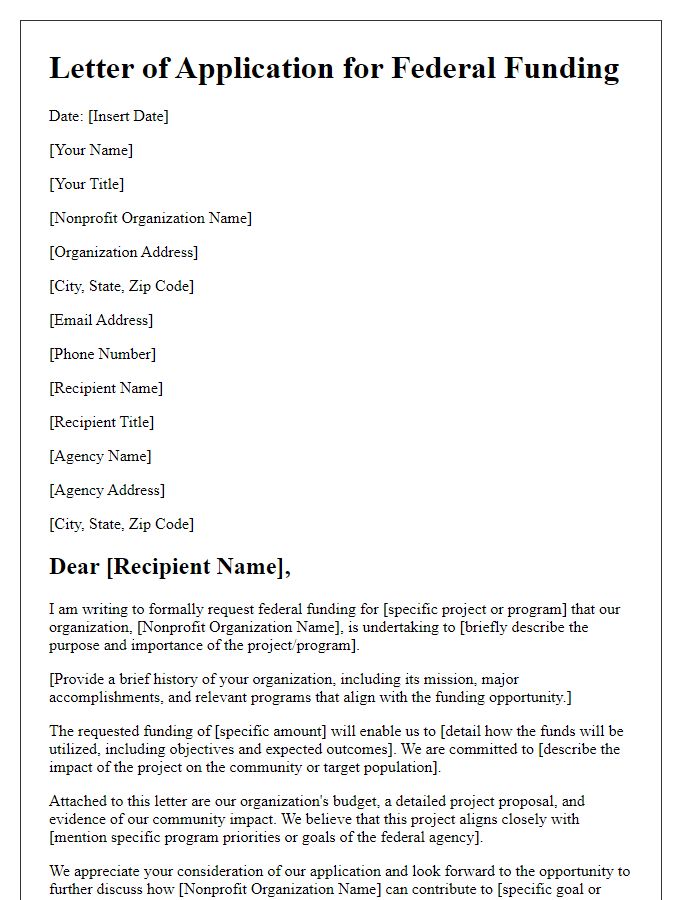Are you looking to secure federal funding for your project? Writing an effective application letter can make all the difference in capturing the attention of decision-makers. In this article, we'll guide you through the essential elements of a compelling letter that showcases your mission, vision, and the impact of your work. So grab a cup of coffee and dive inâwe've got valuable tips waiting for you!

Clear project objectives and goals.
Clear project objectives and goals are vital for successful federal funding applications. Specific aims include advancing educational access (targeting underserved communities) and promoting sustainable practices (aligning with federal environmental regulations). Measurable outcomes could involve increasing student enrollment by 25% (to achieve equity) and reducing carbon emissions by 30% over three years (to support national climate initiatives). Achievable targets should reflect the project's capacity, such as securing partnerships with local organizations (to enhance community engagement). Relevant objectives should connect to current federal priorities, such as improving infrastructure (which plays a key role in economic growth). Time-bound goals must detail a timeline, for instance, implementing program phases within six months and achieving baseline assessments by the end of the first year, ensuring accountability and transparency throughout the funding period.
Detailed budget and funding requirements.
The detailed budget for federal funding applications often includes essential components such as personnel costs, which may account for salaries of project staff, calculated based on annual salary rates multiplied by percentage of time dedicated to the project. Additionally, operational expenses encompass supplies (like paper, software licenses) and travel costs (including transportation, lodging, meals associated with project-related meetings or fieldwork). Equipment costs should specify major purchases required for project execution, with unit prices and quantity. Other categories like indirect costs might evaluate overhead expenses necessary for supporting the project infrastructure, often defined by a negotiated rate with federal agencies. The funding requirements should clearly outline the total funding request, breaking down the amounts requested from the federal sources and any matching contributions or in-kind support from local partners, ensuring both transparency and accountability in the financial plan laid out for the proposed project, which could span multiple years.
Evidence of organizational capacity and expertise.
The organization's extensive experience in managing federal grants, such as the $2 million awarded by the Department of Health and Human Services for community outreach programs in 2022, demonstrates robust organizational capacity. With a team comprising over 30 dedicated staff members, including certified project managers and licensed social workers, the organization ensures thorough oversight and effective implementation of grant initiatives. Additionally, partnerships with local universities, like the collaboration with the University of California, Riverside, provide access to research and data analysis expertise crucial for evaluating program outcomes. Past projects, including the successful launch of the "Healthy Communities Initiative," have solidified a reputation as a trusted entity in the region, capable of delivering measurable impacts and fostering sustainable community development.
Strong impact and outcomes measurement plan.
A strong impact and outcomes measurement plan for federal funding applications focuses on defining clear, measurable objectives that align with the funding agency's goals. Essential components include specific metrics such as pre-and post-intervention assessments, baseline data collection, and regular reporting timelines. Events like quarterly reviews can enhance accountability while surveys and interviews with stakeholders such as beneficiaries and community leaders can provide qualitative insights. Locations such as community centers or schools serving diverse populations may serve as primary sites for implementing initiatives. Integration of data analysis methods, such as mixed-method approaches, ensures comprehensive evaluation of program effectiveness. Finally, a feedback loop involving all stakeholders, including funders and participants, fosters continuous improvement and ensures that outcomes are not only achieved but also sustained over time.
Compliance with federal guidelines and criteria.
Compliance with federal guidelines is essential for successful funding applications within government programs. Adherence to specific criteria, such as the Code of Federal Regulations (CFR) Title 2, Part 200, which governs Uniform Administrative Requirements, Cost Principles, and Audit Requirements, ensures all applicants meet necessary standards. Additionally, applicants must align with grant-specific requirements provided by the federal agency, such as the Department of Health and Human Services or the National Science Foundation, which outlines funding purposes, eligibility, and reporting obligations. Proper documentation, including the project narrative, budget justification, and proof of eligibility, must be meticulously organized to facilitate the evaluation process and demonstrate commitment to the responsible use of taxpayer dollars. Understanding and implementing these guidelines is crucial for receiving funding and maintaining transparency throughout the project lifecycle.
Letter Template For Federal Funding Application Samples
Letter template of federal funding application for community development projects

Letter template of federal funding application for environmental sustainability projects

Letter template of federal funding application for technology innovation

Letter template of federal funding application for nonprofit organizations










Comments